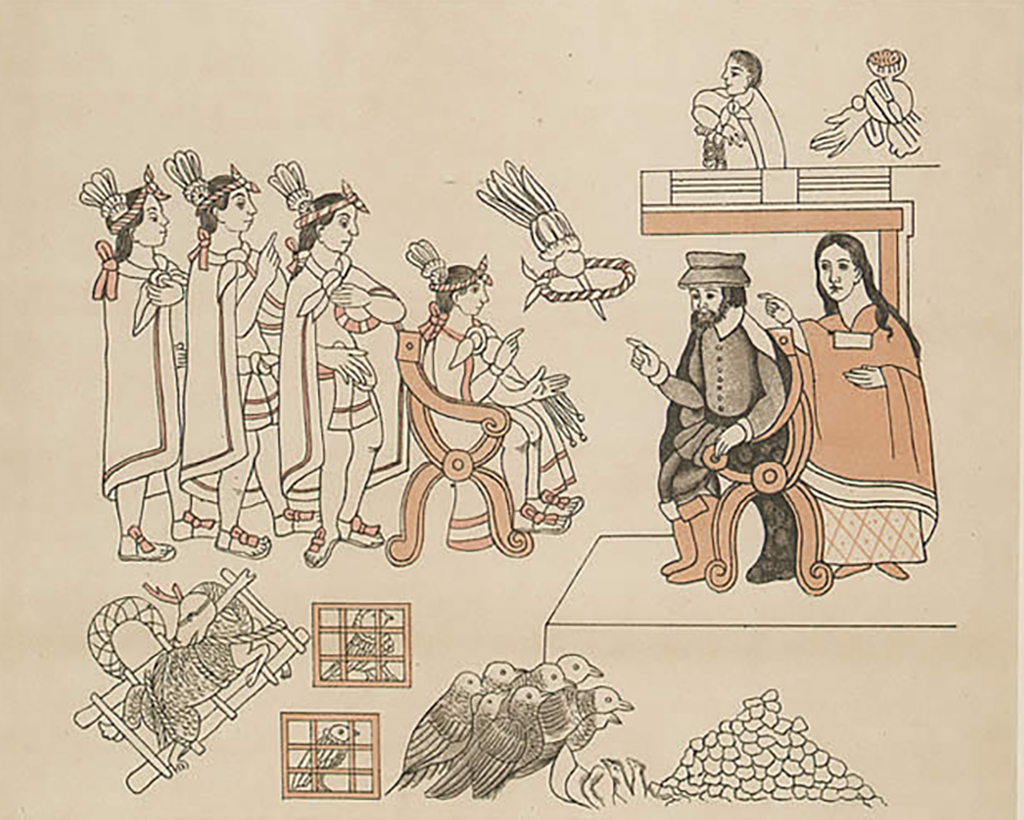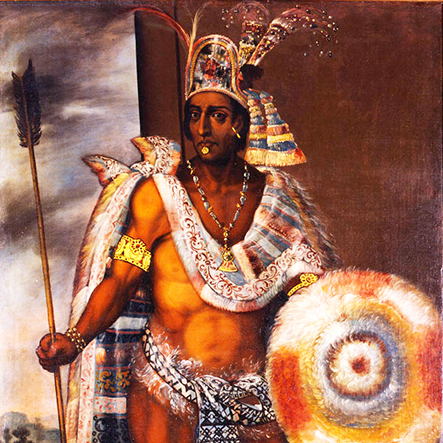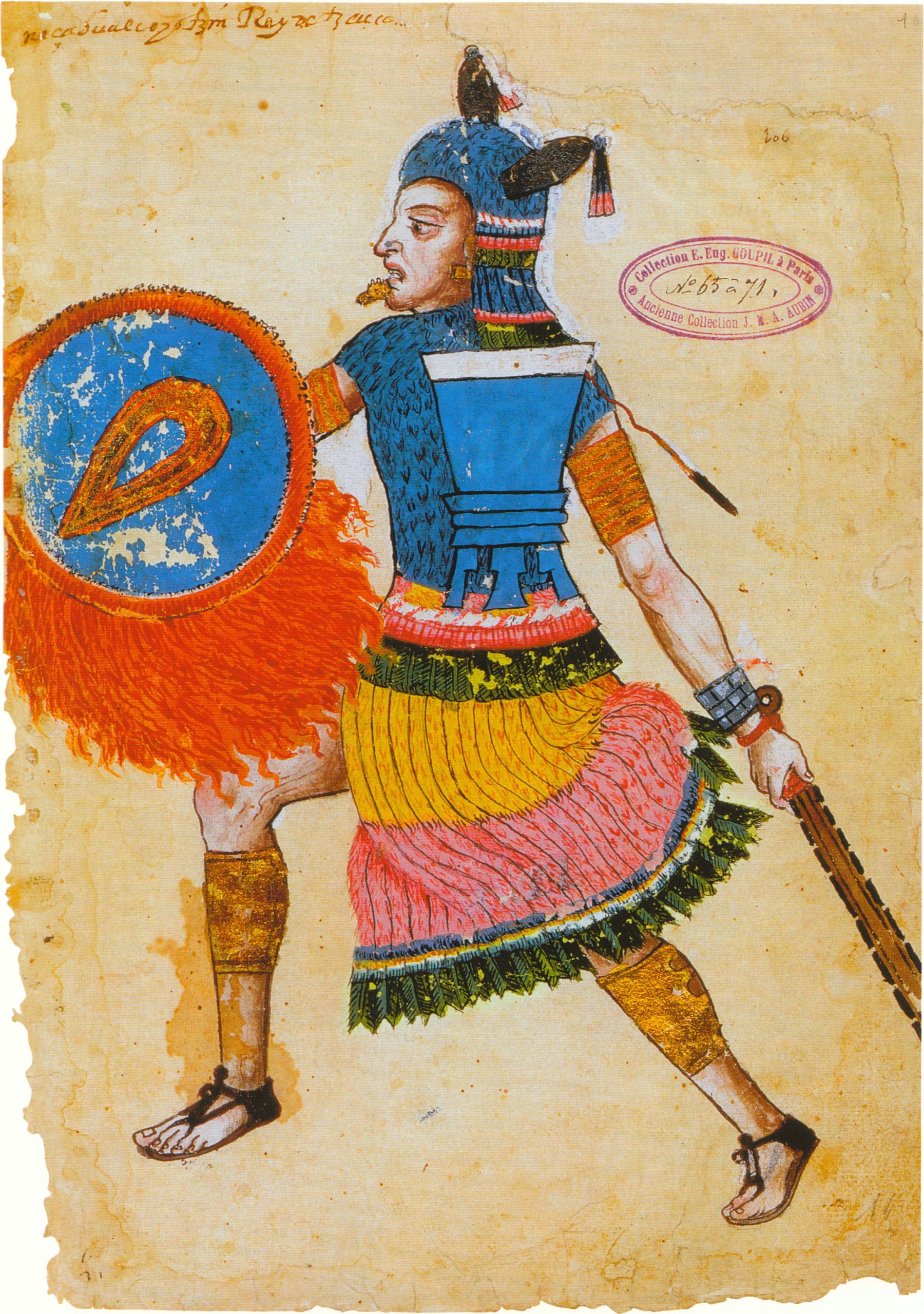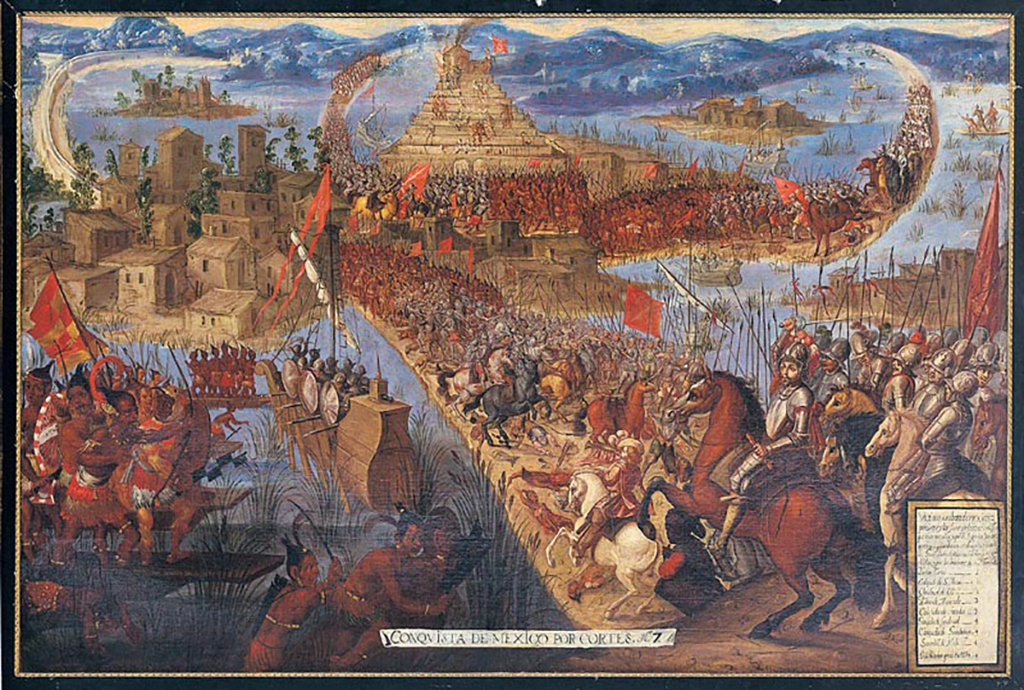Indios amigos (one Coronado historian’s term for indigenous allies) were absolutely essential to all of the conquests enacted by Spaniards during the sixteenth century. As leader of the expedition that pacified the great Aztec Empire, Hernán Cortés has been remembered as the archetypical conquistador. Without native allies, including an interpreter and other elements of the long-established pattern of conquest, Cortés’ efforts would have likely fallen flat.
During the early decades of the 1500s, the Caribbean was the administrative center of the Spanish Empire in the Americas. Its various islands were the first targets of conquistadores’ ambition. From Cuba, new exploration and colonization missions fanned out to other islands. By 1520, slaving expeditions became more and more prominent as Caribbean populations succumbed to European diseases, violence, and overwork. According to some estimates, only about thirty thousand native people remained on Hispaniola in 1520. Early reports had claimed that the island was very densely populated. As they searched for laborers, Spaniards also hoped to find great cities of wealth or fabled items, such as the Fountain of Youth or the Sierra Azúl (rumored to contain a mountain of pure silver). They also searched for the Strait of Anián (which the English called the Northwest Passage), a much hoped-for waterway through the Americas that would allow European sailors to make their way to the Asian spice trade.
Pre-columbian Mexico
Pre-Columbian Mexico This animation illustrates the extent of the Aztec Empire and the Mayan cultural zone in Mesoamerica just prior to the arrival of Spaniards.
In 1517 a group of Spanish explorers landed on the shores of the Yucatán peninsula where Maya peoples told them of a great civilization further inland. Up to that point, Spanish explorers had conquered native peoples that lived in small villages. Even in their current state of decline, Maya cities exceeded anything that the Europeans had yet seen in the Americas. Members of the first expedition dreamed of means to take control of the area and its people. After initial contacts that the Spaniards interpreted as friendly, however, Maya warriors forced them to retreat. The next year, another group returned in an attempt to secure small amounts of gold in Maya temples, reported by the earlier expeditionaries. The 1518 excursion returned to Cuba once again with news of a marvelous society beyond the coast.
Cortés' Route from Cuba to Tenochtitlan
Cortés’ Route from Cuba to Tenochtitlán Cortés first landed among Maya peoples in the Yucatan Peninsula before proceeding along the coast to the site of present-day Veracruz. With the aid of his captive interpreter and a number of indigenous allies, he led his forces inland to the great city of the site of present-day Mexico City.
When Cuban Governor Diego Velásquez issued the call for someone to lead an expedition to the mainland, Hernán Cortés jumped at the chance. Cortés came from a family of minor nobility in the region of Extremadura in west-central Iberia. Seeking adventure and the opportunity to increase the wealth and standing of himself and his family, he sailed to Santo Domingo in 1506. He distinguished himself in battle by quelling a native revolt and by participating in the conquest of Cuba in 1511. Once the indigenous Taíno people (called Arawak by the Spaniards) were subdued, Velásquez received the governorship and Cortés, just twenty-six years old, was named treasurer of the new colony. Cortés married a Spanish woman of high status to further increase his prestige.
Who were the Taíno of Hispaniola?
Find out who the Taíno of Hispaniola were from Yale University.
His desire to lead the expedition to the mainland was not based on simple plunder. Cortés coveted the power and authority that would come to him through conquest. As he made his preparations for the expedition, Governor Velásquez recognized Cortés as a threat to his own authority and ordered him to abandon the journey. With eleven ships and nearly five hundred men set to leave, however, Cortés ignored the governor’s attempt to revoke his commission and set sail.
Cortés’ forces made landfall near the present-day port city of Veracruz, then at the center of a northern group of Maya city-states. His soldiers quickly overpowered a group of warriors and negotiated a truce with the local people. In the process, Cortés met Gerónimo de Aguilar, a survivor of a Spanish shipwreck on the coast a decade earlier. Aguilar acted as translator for the expedition. The defeated Mayas presented Cortés with a group of twenty young women to solidify peaceful relations with the Spaniards. One of these women was named Malintzin, later known to the Spanish as Doña Marina or Malinche. Her captors soon realized that she was able to converse not only with Mayas, but also with Nahuatl-speaking people. Her services were invaluable to the Europeans as they moved toward the Aztec capital of Tenochtitlán. She translated Nahuatl into the Mayan dialect in order to speak to Aguilar who then translated the conversation into Spanish (Castilian). After only a short time, Malintzin learned to speak Spanish as well, and she took complete responsibility for the translation efforts.
Malintzin has come to represent many different things to different groups of people since her lifetime. “Malinche” is a highly derogatory term used in current Mexican Spanish to refer to someone who is a traitor. During the period of Mexican nationalism that followed its early-twentieth-century Revolution, Malintzin was remembered prominently as the woman that betrayed her own people by facilitating the conquest. Yet she had been sold by her own people, a Nahua group subject to the Mexica, into slavery among the Mayas as a young girl. At the time that she was given to Cortés’ party, she was probably about fourteen or fifteen years old. It seems that she would have had no real affinity for either her Nahua relatives or the Mexica since they had placed her in a state of servitude. She recognized the opportunity to “improve her grim situation by making herself an invaluable member of the expedition.”8 Cortés fully realized her vital place in his mission of conquest. Significantly, he did not take her as his mistress until after the fall of Tenochtitlán. He could not risk her becoming pregnant.

As the expedition’s interpreter, Malintzin became a particularly important indigenous ally. Without the military support of thousands of others, however, her contributions may have come to naught. Following another long-established pattern of conquest, Cortés also worked to discover the existing political situation in the Aztec heartland. He learned that the Mexica had subjected many central Mexican peoples to their rule over the previous couple of centuries and that many of those tributary groups wished to throw off the yoke of Aztec rule.
By exploiting existing political and social divisions, Cortés was able to reverse his numerical disadvantage. Early in the Spaniards’ march inland from the coast, they encountered discontented village leaders who offered them the services of hundreds of porters. Then, Cortés learned that the people of Tlaxcala were antagonistic toward the Mexica. After the Spaniards defeated them in battle, the Tlaxcalans pledged their military support for the expedition against Tenochtitlán. There were several other Nahuatl-speaking groups that opposed Mexica dominance. Most chafed under the burden of the tribute that was required of them. Still, others disliked the official religion of the Aztec Empire that had been imposed upon them. All seemed to recognize the power and determination of the Spaniards and sought to make alliances with the new military and political forces in the region.
Moctezuma II (referred to in Nahuatl texts as Moctezuma Xocoyotl, “the young”) sat at the head of the Aztec Empire in 1519. He was the ninth head of the empire, and his rule had begun in 1502. He was impressed by the horses and weapons that the Spaniards brought with them, and he considered the newcomers to be prospective allies or even potential subjects. Although he has often been described as weak and deferential, he is better characterized as a shrewd leader that sought to bring the Spaniards under the Aztec imperial umbrella. As Cortés’ army marched toward Tenochtitlán, Moctezuma sent emissaries bearing gifts. Early commentators and historians considered this action to be a sign of Moctezuma’s feeble reaction to the Spaniards’ presence, yet his actions suggest the exact opposite when considered in the context of Mexica traditions. In Mexica custom, gift-giving was a means of demonstrating power and wealth. The gifts, then, were intended to create friendly relations and to show the Spaniards that they were dealing with a leader of great authority and ability.

Moctezuma II
Ninth tlatoani(ruler) of Tenochtitlan from 1502 to 1520. During his reign, the first contact with Europeans was made with the Aztecs

Nezahualcoyotl
Nezahualcoyotl, the ruler of Texcoco from 1431 to 1472, was renowned for his poetry, religious skepticism, and political allegiance with the Mexica (Aztecs). This image is featured in Codex Ixtilxochitl.
Moctezuma had many reasons to have considered himself in the dominant position. Much like the Iberians, the Mexica constructed their society through conquest. Aztec forces had brought the neighboring peoples of Texcoco and Tlatelolco together in the Triple Alliance in the late 1400s. Although the three rulers theoretically shared power, after the death of the powerful Texcoco King Nezahualcoyotl in 1472, the Mexica ruler dominated political affairs. Although Moctezuma could not have known it, the city of Tenochtitlán was larger and more prosperous than European capitals of the time. Seville, Barcelona, and Córdoba contained less than 50,000 residents each. The largest European capitals at Paris and London boasted about 100,000 inhabitants. According to the best estimates, Tenochtitlán was home to between 200,000 and 250,000 people. The Valley of Mexico (the present-day Mexico City metropolitan area) contained several other cities and a total population of between one and two million.
By all accounts, those connected to Cortés’ contingent were both awed and perplexed by Tenochtitlán. The great city was built on an island in Lake Texcoco, connected to the shore via a series of causeways. Its peoples’ ability to prosper through chinampa agriculture on the Texcoco shores and swamps impressed the soldiers. Yet the Mexica religion, with its use of bloodletting and human sacrifice, was an aberration to them. Most could not reconcile the grandeur of Tenochtitlán’s buildings and temples with the barbaric, pagan practices they heard about and witnessed. Indeed, as the conquest progressed, Cortés’ forces destroyed Mexica religious figures and symbols and replaced them with statues and images of Catholic saints, the Virgin Mary, and Jesus Christ.

Codex Chronicles of Aztec Life
Miscommunications characterized that ceremonious meeting between the two leaders on one of Tenochtitlán’s causeways in November of 1519. In spite of barriers to understanding, if not to communication, Moctezuma invited Cortés and his closest advisors into his palace. Over the next few months, an uneasy peace existed between the various peoples of the Valley of Mexico and the Spaniards, with their Tlaxcalan allies. The calm was shattered when Cortés placed Moctezuma under arrest in his own palace, and his soldiers took violent measures against Aztec priests in order to prevent them from practicing their traditional rites. In the spring of 1520, Cortés received word that Governor Velázquez had sent an army from Cuba led by Pánfilo de Narváez to bring his conquest to a halt. In response, he led a contingent to the coast while eighty of his captains remained in Tenochtitlán. In his absence, Pedro de Alvarado supervised the massacre of priests, as well as women and children, at the Templo Mayor (Main Temple) in the center of the city. A fierce rebellion against Spanish authority broke out, led by Moctezuma’s brother Cuauhtémoc. On July 1, 1520, in an event remembered by the Spanish as “La Noche Triste” (often translated to English as the Night of Sorrows), the remaining Spaniards were forced from the city.
Meanwhile, Cortés overpowered Narváez’s men and convinced them to join his conquest. Upon his return to Tenochtitlán, he attempted to salvage the situation by forcing Moctezuma to address the people of the city at his side from the balcony of the royal palace. In the process, the Emperor was killed. Although accounts differ—some indicate that Cortés murdered Moctezuma, others that he was shot down by his own people—the people of Tenochtitlán once again forced the Spaniards from the city upon his death. Cortés ordered his forces to regroup at Tlaxcala. The following December, about 550 Spanish soldiers and nearly 10,000 Tlaxcalans initiated their march toward the Valley of Mexico. The attack on Tenochtitlán began in May 1521, and it quickly became a battle of attrition. In August, after months of intense hand-to-hand conflict in the streets, forces allied with the Spaniards captured Cuauhtémoc, who had taken the title of emperor upon his brother’s death.
Cortés had indeed conquered one of the two largest and wealthiest civilizations in the Americas, but he could not have done so without the aid of Malintzin and Tlaxcalan allies. Other key factors in the Spaniards’ success were technology and disease. Lacking immunity to European sicknesses, thousands upon thousands of native people died after the initial contact. Smallpox, influenza, typhus, measles, diphtheria, and whooping cough were among the devastating ailments that struck the peoples of the Americas. Firearms, including harquebuses and cannons, as well as the use of armor and horses gave the conquistadores a distinct advantage, but not as insurmountable as has previously been reported. Scholars have indicated that Spanish cannons were few in number, firearms inefficient and inaccurate, and armor in short supply. Another common misconception has been that Aztecs and others believed the Spaniards to be gods, therefore offering obeisance rather than resistance. Compelling recent research, however, illustrates such assumptions to be false.
The victorious Spaniards placed themselves at the head of the former Aztec Empire, rebuilding their own colony of New Spain atop existing administrative structures. They also literally built chapels and cathedrals on top of the ruins of Aztec temples in Tenochtitlán. In the years following the initial conquest, a new society took shape that was dominated by Catholicism and a transplanted version of the Iberian caste system. Society was heavily stratified, with Spaniards who claimed limpieza de sangre at the top, and peoples of indigenous and African descent at the bottom. After only a few short years, a large class of mestizos emerged to fill the middle sectors of society.
Mestizos were people of mixed heritage, most often the children of Spanish fathers and indigenous mothers. Tellingly, syphilis was the one disease that disproportionately inflicted Europeans after contact. In 1512, the Laws of Burgos had established standards for the treatment of indigenous peoples. The laws indicated that natives were worthy to receive conversion to Catholicism and participate in Spanish imperial society. Despite their low place in the social structure, they were included as subjects of the empire rather than excluded from colonial society and pushed off of their lands as would be the British model of conquest.
The Conquest of Mexico
Perspectives change with new historical discoveries. Here are new perspectives on the Conquest of Mexico:
- Camilla Townsend: “Burying the White Gods: New Perspectives on the Conquest of Mexico“
- Tlatelolco’s Plaza of Three Cultures (Plaza de las Tres Culturas)

